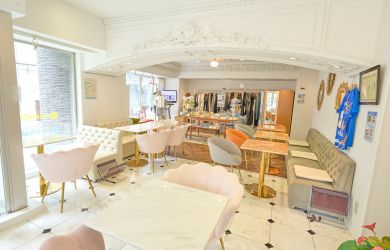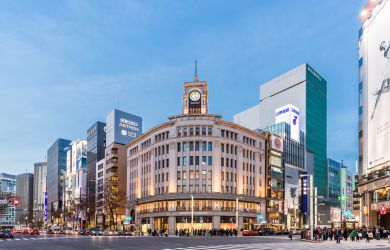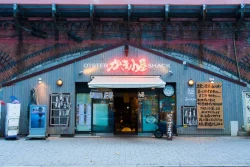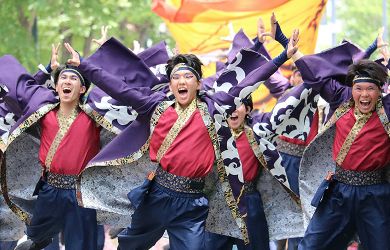
September 11, 2008
Off the Books
Toss away your tourist guides—Metropolis gives you the scoop on Tokyo’s true hotspots
By Metropolis

Genius (Courtesy of Genius)
“To visiting movie stars, fashion models, and other members of the international jet set, the Lex is the place to party hard and go wild—and be seen doing it.”—Fodor’s Tokyo, 1st edition
For after-hours dancing in Tokyo, the guidebooks will point you to just a handful of locations, mostly around Roppongi, Shibuya or Shinjuku. But search outside the triangle for some thumping finds. Genius (3-6F 646 Bldg, 6-4-6 Ginza, Chuo-ku; 03-3571-5830; www.genius-tokyo.co.jp) boasts four floors of party space in the heart of Tokyo’s swankiest neighborhood yet manages to avoid the spotlight. Suits are worn by nearly everyone, as many of the mostly 30-plus Japanese clientele head there after work. Entrance is free for ladies on Saturdays.
On the other side of town in leafy Gaienmae is Pantera (B1 NA Bldg, 2-7-28 Kita-Aoyama, Minato-ku; 03-6423-0404; www.pantera-tokyo.com). Steps from Jingu Baseball Stadium, this underground space is divided into four parts: executive room, “royal” executive room, stylish all-white bar counter and dancefloor. As for music, expect everything from ’80s anthems to house and hip-hop.

Miralkan (©National Museum of Emerging Science and Innovation)
“The Tokyo National Museum is the one museum in Tokyo worth a spot in your itinerary. Not only is it Japan’s largest… it also has the world’s largest collection of Japanese art.”—Lonely Planet Japan, 10th edition
The TNM (www.tnm.go.jp) is certainly worth a visit, but the large collection draws even larger crowds. If you’re looking for a more intimate art-viewing experience, check out the Watari-um Museum of Contemporary Art (3-7-6 Jingumae, Shibuya-ku; (www.watarium.co.jp). Designed in 1990 by architect Mario Botta, the Watari features exhibitions by established and emerging contemporary artists from Japan and around the world. Past shows have featured works by such luminaries as Gary Hill, Carsten Nicolai and Katsumi Watanabe. The museum also hosts regular lectures and workshops, including a series aimed at introducing contemporary art to young children.
Also well worth a visit is the National Museum of Emerging Science and Innovation in Odaiba, a.k.a. Miraikan (2-41, Aomi, Koto-ku; www.miraikan.jst.go.jp). Its somewhat out-of-the-way location make the casual museum-goer inclined to overlook it, but with interactive exhibits on everything from space flight to submarines to DNA, this museum will capture the fancy of all ages.
“Takeshita Dori buzzes with bleach-headed teenagers shopping for illiterate T-shirts and fishnet stockings.”—Lonely Planet Japan, 10th edition
If hordes of giggling teenagers aren’t your thing, take a trip over to Jizo Dori in Sugamo, affectionately known as “the obachan’s Harajuku.” While the area does boast several shops selling the “health-promoting” red underwear favored by the over-70 crowd, there are also a number of boutiques full of souvenirs and accessories, as well as traditional Japanese sweets. To get there, take the Yamanote line to Sugamo station.
Despite the ritzy-sounding name, Yanaka Ginza in Taito-ku offers shoppers a true taste of old Japan. The atmosphere of this small shotengai hasn’t changed much in the past 100 years, and it remains a popular pedestrian destination. The area has several famous shops selling green tea and traditional Japanese foods like wagashi, tofu and fresh seafood. Access via Sendagi station on the Chiyoda line.

Inokashira Park (Meredith Deaton).
“Formerly the private estate of a feudal lord and then of the imperial family, Shinjuku Gyoen is considered one of the most important parks of the Meiji Era.”—Frommer’s online
Few green spaces in Tokyo have the historical resonance of Inokashira Park. Situated snugly between the leafy neighbor- hoods of Mitaka and Kichijoji, it was established as an imperial gift to the city in 1913. The famous pond in the center is lined by approximately 400 cherry trees, making it one of the city’s best-loved hanami spots. On weekends year-round, the park hosts ART*MRT, an outdoor art market that also draws performers of all stripes to rival the scene at Yoyogi Park. Its natural beauty makes Inokashira a favorite haunt for couples, especially in spring, but look out if you decide to take your special someone there on a date: the shrine along the West side of the pond is home to Benzaiten, a vengeful goddess of love. Legend has it that she places a curse on couples, dooming their love to failure. The park is just a short walk from Kichijoji station or the Inokashira Koen station on the Keio Inokashira line.
“[Insomnia Lounge] will keep the sleepless going ’til dawn with a good mix of music, cocktails and decent food.”—Tokyo Encounter (Lonely Planet), 2007
Its dead-center Shibuya location means that Insomnia (26-5 Udagawacho; 03-3476-2735) is surrounded by kiddy-bopper brigades searching for their karaoke fix. In other words, not the ideal neighborhood to elbow your way through while trying to impress a date. For that, head down to Ginza’s Mu Mu (6-4-6 Ginza, Chuo-ku; www.mu-mu.info), a sleek and stylish late-night lounge that serves inexpensive food and drinks in an eye-catching, two-level interior.
Over in Roppongi, Charcoal Bar Tunnel (7-19-9 Roppongi, Minato-ku; http://r.gnavi.co.jp/p496200) is our new favorite lounge thanks to the kitchen’s simply prepared but exquisite grilled-meat and -vegetable dishes. The food menu is complemented by a small walk-in wine cellar, and the date-friendly interior boasts a casually elegant vibe.
“Coffee shops like Doutor, Mister Donuts, Starbucks and the slightly upmarket Tully’s… search these places out for a cheap breakfast or a quick bite.”—The Rough Guide to Tokyo, 4th edition
For a locally flavored alternative to these chains—and to coffee—stop by one of the many branches of Koots Green Tea (www.koots.jp). The shop serves a standard “ocha of the day” for ¥290, but also innovative drinks like matcha kuromitsu tapioca, with black sugar syrup. Koots also offers healthy bites to eat, including a wide variety of onigiri, miso soup and rice bowls (¥880). Locations include Tokyo Midtown (9-7-2 Akasaka, Minato-ku; 03-5413-7131), Roppongi Hills (6-2-31 Roppongi, Minato-ku; 03-5775-4750) and Azabu-Juban (2-1-3 Azabu-Juban, Minato-ku; 03-5427-5886).
“Retro cafes like Shichimencho and One’s Diner retain [an] individual style.”—Explorer Tokyo: The Complete Residents’ Guide, 1st edition
These two Western-style coffee shops smack dab in the middle of the city are certainly distinctive, but for a more wafu café experience, try Kasoyo (2-19-21 Shimo-Ochiai, Shinjuku-ku; 03-3565-3265; www.kasoyo.com). The owner is a kimono maker and teacher, so you can expect to be served by staff clad in traditional clothes. The retro feel continues on the menu, which features anmitsu (anko and kanten jelly) and good ole matcha. Though located in Shinjuku, Kasoyo has a wooden terrace for a quiet, contemplative cup of tea.
Likewise, Tsurumakijaya (2-18-2 Tsurumaki, Setagaya-ku; 03-5799-3257; www.tsurumakijaya.com) sits in a 35-year-old Japanese house with a traditional garden, but also has hints of an international flavor thanks to North African furniture and a kitchen that serves up Moroccan and Spanish fare.
Kosoan in Jiyugaoka (1-24-23 Jiyugaoka, Meguro-ku; 03-3718-4203; www.kdknet.com/j_kosoan) is another Japanese-style refuge, with tables and futons laid out on a tatami-lined space. The owner is an artist who has decorated the interior with classic ceramics and artworks, giving the café a homey and friendly feel.






